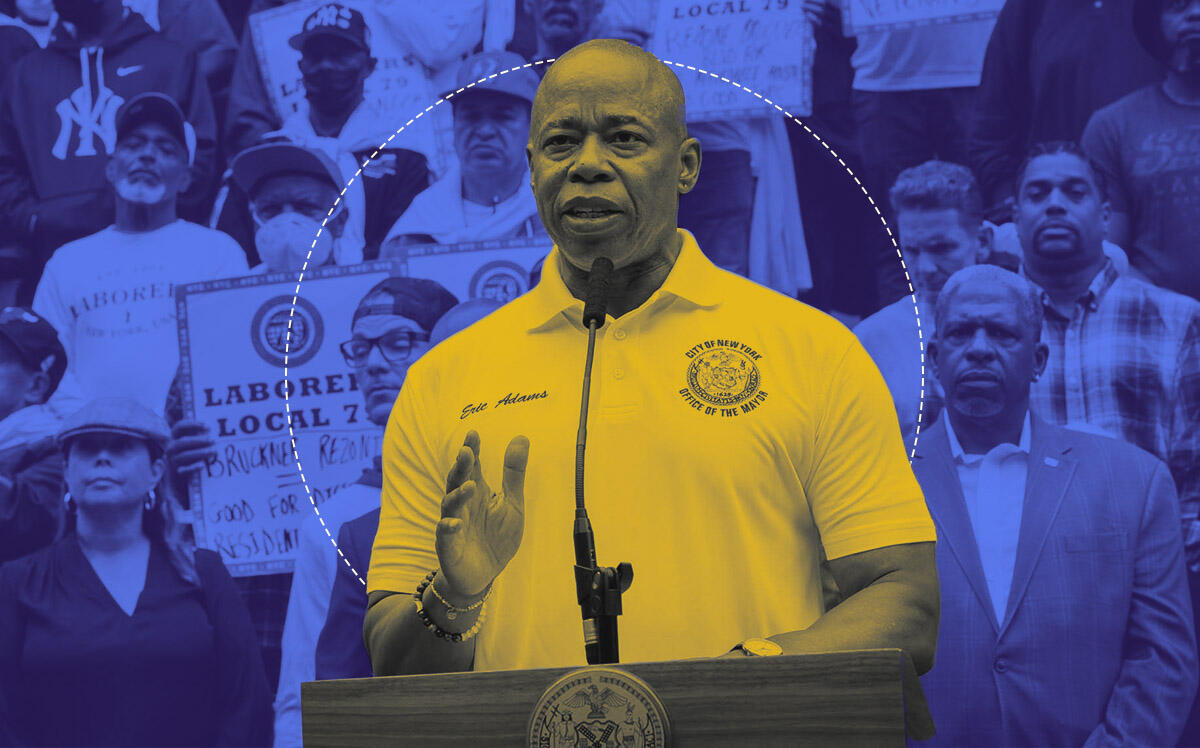 Bronx BP defies Nimbys on controversial Throggs Neck project
Bronx BP defies Nimbys on controversial Throggs Neck project
Trending
This is the Eric Adams that real estate has been waiting for
Mayor campaigned for more housing, but had not done much until now

During his campaign for mayor, Eric Adams said all the right things about building more housing. But in the first nine months of his tenure, he didn’t do much of anything about it.
On Wednesday, that changed.
The mayor spoke at a rally by organized labor for a Bronx project that would build 349 apartments, 94 of them affordable and some specifically for veterans and seniors, as well as revamp a supermarket and create 40,000 square feet of commercial space.
Why is Adams’ support a big deal? The project needs a rezoning, and mayors almost always leave the decision to the City Council, which in turn defers to the local member.
For decades, this hands-off approach has generally worked out — albeit with more drama than developers would like — because nearly all Council members like making deals to get things built in their districts.
But in May, a 917-unit, half-affordable project on West 145th Street was killed by Harlem Council member Kristin Richardson Jordan in what the mayor’s own planning commissioner, Dan Garodnick, later called a missed opportunity.
Missed by whom? Certainly the Council dropped the ball, but so did Adams. Rather than intervene to get a deal done, Adams had said it was up to the developers, led by Bruce Teitelbaum, to sell the community on their project, One45.
At best, that was a miscalculation. At worst, it was a cop-out.
Jordan, an avowed socialist, was never going to approve a financially viable project. She made that clear from the outset when she demanded every unit be affordable, and deeply affordable at that. Such units are money-losers, so when Adams did not pressure the rest of the Council to override Jordan, Teitelbaum had to pull out.
The same thing could now happen with the Bronx project as well as other much larger developments that need rezonings, such as the $2 billion Innovation QNS in Long Island City proposed by Larry Silverstein and others. Council members Marjorie Velázquez and Julie Won, who will respectively decide those applications, have been critical of them.
After the Harlem debacle, that can no longer be written off as posturing to gain leverage. Most of the 51 Council members are now potential project killers.
They were watching closely when the Democratic Socialists of America crushed real estate’s preferred candidate in a Queens Senate race last month, and they saw Jordan emerged unscathed from her defiant rejection of mixed-income housing. Other politicians might well conclude that stopping for-profit development will spare them from a DSA challenge in the next election.
You might be thinking, Gee, isn’t solving the city’s housing shortage more important? Unfortunately, most elected officials put winning the next election above all else. If maximizing their chances requires killing projects, they will convince themselves that killing projects is good for the city.
A fair number already have. They insist that mixed-income housing causes gentrification, displacement and higher rents, despite all the evidence to the contrary. This week, socialist Sen. Jabari Brisport tweeted “I support building more affordable housing,” but omitted that he only does if no market-rate housing comes with it. That’s a common position on the far left.
The socialists, though, are only half of what the mayor is up against. Nimbys — the “not in my back yard” people — are the other half, starting with the ones in Throggs Neck.
Endorsing that rezoning, proposed by several small property owners, was politically safer for Adams than backing a billionaire’s megadevelopment, but it was still bold in that it broke with custom. The same could be said for the Democratic mayor’s endorsement of several candidates, including hopeless underdogs, against ultra-progressive opponents in last month’s Democratic primary.
This is the Eric Adams that real estate has been waiting for — a mayor active not just on crime but on development.
Unlike the DSA dreamers, the mayor is a realist. He knows the city and state can’t subsidize our way out of the housing crisis, but mixed-income projects can. To oppose them is to oppose affordable housing, and yesterday Adams became the rare politician to call out people who do.
“Everyone talks about the need for affordable housing,” he said. “We need it. Let’s build housing. Oh, but not on my block. Not in my neighborhood, not near my path, not near my school. No, that can’t happen.’”
Read more
 Bronx BP defies Nimbys on controversial Throggs Neck project
Bronx BP defies Nimbys on controversial Throggs Neck project
 How a basic Bronx supermarket rezoning devolved into food fight
How a basic Bronx supermarket rezoning devolved into food fight
 Candidates back affordable housing, but not in their back yard
Candidates back affordable housing, but not in their back yard
How exclusionary is Throggs Neck? The modest project floated there — with no building taller than eight stories — would create twice as many affordable homes as have been built in the entire community district since 2014.
The Nimbys are well aware that they could be construed as racist, so they have tried to get in front of that accusation by brazenly portraying the rezoning plan as racist.
“When the neighborhood was predominantly white, it was down-zoned,” they wrote in a press release, referring to a 2004, Staten Island-style rezoning that Michael Bloomberg surely regrets. “Now that it is a quiet, safe, majority-Hispanic neighborhood, problematic developers want to up-zone it.”
The current mayor was having none of it Wednesday in front of City Hall.
“This is a city where veterans are looking for housing. They protected our country,” Adams said at the laborers union rally. “This is a city where nurses, our porters, our [essential workers] are looking for affordable housing. You gave them a hand clap at 7 p.m. Yet you don’t want to develop in your community to give them the housing they deserve. That is unacceptable.”
Adams was just getting started.
“No neighborhood or community should be exempt from making sure that we allow all our residents to live together,” he went on. “We want to diversify our schools? Diversify our housing. We want to diversify access to healthy food? Diversify our housing. How do we bring down hate crimes? Diversify the community.”
With his gift of gab and ability to command the spotlight, Adams can push Velázquez toward compromise on the Throggs Neck plan. But he will also need diplomacy, and on that front he is unproven.
He was already at odds with the City Council for cutting school funding when enrollment fell (and for pointing out that the Council had approved the cuts). So it’s far from certain he can get members to support the Bronx project, especially if Velázquez doesn’t.
But if he fails on the heels of the Harlem project’s defeat, more dominoes — like Innovation QNS — could fall. Rezoning applications cost developers big bucks, so if the failure rate increases, they will stop filing them, and the housing shortage will never end.
Unless, of course, the Council upzones the whole city at once and stops taking projects hostage. Given its overwrought objections to an eight-story building in Throggs Neck, that is a long shot indeed.




